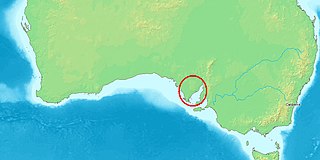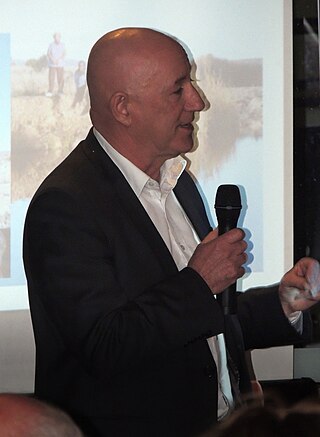Related Research Articles

Whyalla is a city in South Australia. It was founded as "Hummocks Hill", and was known by that name until 1916. It is the fourth most populous city in the Australian state of South Australia after Adelaide, Mount Gambier and Gawler and along with Port Pirie and Port Augusta is one of the three towns to make up the Iron Triangle. As of June 2018, Whyalla had an urban population of 21,742, having declined at an average annual rate of -0.75% year-over-year over the preceding five years. It is a seaport located on the east coast of the Eyre Peninsula and is known as the "Steel City" due to its integrated steelworks and shipbuilding heritage. The port of Whyalla has been exporting iron ore since 1903.

The Spencer Gulf is the westernmost and larger of two large inlets on the southern coast of Australia, in the state of South Australia, facing the Great Australian Bight. It spans from the Cape Catastrophe and Eyre Peninsula in the west to Cape Spencer and Yorke Peninsula in the east.

The Eyre Peninsula is a triangular peninsula in South Australia. It is bounded by the Spencer Gulf on the east, the Great Australian Bight on the west, and the Gawler Ranges to the north.

The giant cuttlefish, also known as the Australian giant cuttlefish, is the world's largest cuttlefish species, growing to 50 cm (20 in) in mantle length and up to 100 cm (39 in) in total length. They can be over 10.5 kg (23 lb) in weight. Using cells known as chromatophores, the cuttlefish can put on spectacular displays, changing color in an instant. The giant cuttlefish is native to temperate and subtropical waters of Australia, from Brisbane in Queensland to Shark Bay in Western Australia and Tasmania to the south. It occurs on rocky reefs, seagrass beds, and sand and mud seafloor to a depth of 100 m (330 ft). In 2009 the species was listed at Near Threatened on the IUCN Red List of Threatened Species due to an observed declining trend at that time.

The City of Whyalla is a local government area in South Australia, located at the north-east corner of the Eyre Peninsula. It was established in 1970, replacing the town commission, which had been running the town previously. The district is mostly industrial, with many large companies having factories in the city.
Whyalla Airport is an airport located 4 nautical miles southwest of Whyalla, South Australia.

Port Bonython is the location of a deepwater port, gas fractionation plant and diesel storage facility west of Point Lowly in the Upper Spencer Gulf region of South Australia. It lies 16 km east-northeast of Whyalla, South Australia and approximately 370 km north-west of the State's capital city, Adelaide. The existing wharf is 2.4 kilometres long and is capable of berthing small Capesize ships with a maximum capacity of 110,000 tonnes. The wharf was established in 1982 and named after John Bonython, the founding chairman of Santos. The structure is leased to Santos by the Government of South Australia and is used for the export of hydrocarbon products. An oil spill at Port Bonython in 1992 resulted in loss of bird life and damage to mangrove habitats to the west and southwest of Port Pirie.
The Hundred of Cultana is a cadastral unit of hundred located on the upper Eyre Peninsula in South Australia just north of Whyalla. It is one of the seven Hundreds of the County of York. It was proclaimed in 1940 by Governor Malcolm Barclay-Harvey and named for a Cultana Hill, the term Cultana deriving from a local indigenous term.

The Whyalla Steelworks is a fully integrated steelworks and the only manufacturer of rail in Australia. Iron ore is mined in the Middleback Range to feed the steelworks, resulting in the distribution of finished steel products of over 90 different grades. It occupies a 1,000 ha site on the shore of False Bay, Spencer Gulf and is the largest employer in Whyalla, South Australia.

The Olympic Dam mine is a large poly-metallic underground mine located in South Australia, 550 km (340 mi) NNW of Adelaide. It is the fourth largest copper deposit and the largest known single deposit of uranium in the world. Copper is the largest contributor to total revenue, accounting for approximately 70% of the mine's revenue, with the remaining 25% from uranium, and around 5% from silver and gold. BHP has owned and operated the mine since 2005. The mine was previously owned by Western Mining Corporation. Since the 1970s environmentalists, traditional owners and others have campaigned against the mine, largely on the basis of its contribution to the nuclear cycle and its use of underground water.

Point Lowly is the tip of a small peninsula north north-east of Whyalla in the Upper Spencer Gulf region of South Australia. The wider peninsula is shared by a combination of defence, industrial, residential, recreational and tourism interests. Port Bonython lies immediately to the north-west and is marked for future industrial expansion, driven by anticipated growth in the State's mining industry. The icons of the peninsula are the historic Point Lowly Lighthouse and the mass breeding aggregation of Australian giant cuttlefish which occurs inshore each winter.

The Point Lowly lighthouse was constructed in 1883 to guide ships safely through Spencer Gulf en route to Port Augusta and Port Pirie in South Australia. It was upgraded several times before being deactivated in 1993. It was reactivated in 1995 and is a tourist attraction for the Whyalla area and an icon of the Point Lowly area.
The Whyalla News is a newspaper serving the town of Whyalla on Eyre Peninsula, South Australia since 1940. It was later sold to Rural Press, previously owned by Fairfax Media, but now an Australian media company trading as Australian Community Media.

Edward Joseph Hughes is an Australian politician representing the South Australian House of Assembly seat of Giles for the South Australian Branch of the Australian Labor Party since the 2014 state election. Hughes was previously a long-serving member of the Whyalla City Council. Hughes has expressed strong support for South Australia's development of its renewable energy potential as a Councillor and as a member of Parliament.
The False Bay is an 11-kilometre (6.8 mi) wide south-southeasterly facing bay in South Australia's upper Spencer Gulf region. It extends from the Whyalla steelworks at the southern end to Black Point at the eastern end. It features very wide, low gradient tidal, sand and salt flats which are up to 7 kilometres (4.3 mi) wide. Five very low energy, rarely visited beaches are accessible to the public. The two boundary beaches are accessible by vehicles from the Port Bonython Road while the central three are surrounded by salt and tidal flats and tidal creeks. False Bay's beaches are not patrolled but are rated among the state's least hazardous.

The South Australian Chamber of Mines and Energy (SACOME) is a not-for-profit, non-government organisation founded in 1979. It represents approximately 130 companies involved in resource extraction and supporting service industries in South Australia.
Save Point Lowly is a community action group based in Whyalla, South Australia. The group was formed circa 2008 to present an alternative vision for the future of the Point Lowly area north-west of Whyalla and resist plans for heavy industrialization. The group aspired to raising the profile of the Point Lowly area, including the giant Australian cuttlefish aggregation, which the group believes is under threat from a number of industrial proposals including: a seawater desalination plant for BHP Billiton's Olympic Dam mine, a diesel distribution hub, a technical ammonium nitrate plant and an iron ore export facility. Collectively these development have been referred to by the Government of South Australia as the Port Bonython Minerals Precinct. The group's spokesperson and chairman is Andrew Melville-Smith who is a practising veterinarian and resident of Whyalla.
Richard Yeeles in an English-born Australian businessman and former senior South Australian public servant with interests in the resources sector, particularly uranium mining and processing.
Port Bonython Fuels is a fuel importation and diesel distribution hub at Port Bonython on the Point Lowly peninsula in South Australia's upper Spencer Gulf region. The development was designed to supply the State's expanding oil, gas and mineral resources sectors' operations in the north and west of the state. It allows South Australia to import fuel from ships carrying cargoes in excess of 100,000 tonnes- approximately four times the size of vessels currently importing diesel via Port Adelaide. The project is owned by Petro Diamond Australia, a wholly owned subsidiary of Mitsubishi Corporation. The first stage of the project was officially opened in May 2016.
Fitzgerald Bay is a large bay located between Point Lowly and Backy Point in South Australia's upper Spencer Gulf. The bay's shoreline consists mostly of pebble beaches and sparse grey mangroves. In the 2000s the bay was used for the farming of yellowtail kingfish until their closure circa 2011 in response to high levels of fish mortality. Understanding of the environmental impacts of yellowtail kingfish farming is limited. As of 2021, fish farming has not returned to Fitzgerald Bay, but aquaculture zones remain in place, and Clean Seas is authorised to restock fish farms there. There are approximately forty shacks and coastal homes sparsely distributed along the fringe of Fitzgerald Bay whose interests are represented by the Cultana Jenkins Shackowners' Association.
References
- ↑ Moscaritolo, Maria (2011-09-20). "Port plan is compromised: Engineers". The Advertiser. Retrieved 2014-12-18.
- ↑ Opie, Rebecca (2013-05-22). "Working party says 'act now'". Whyalla News. Retrieved 2014-12-18.
- ↑ Bilney, Kate (2012-10-24). "Point Lowly fight not over". Whyalla News. Retrieved 2014-12-18.
- ↑ "Port group suggests Point Lowly alternative". ABC. 2009-02-19. Retrieved 2014-12-20.
- ↑ Bilney, Kate (2014-08-07). "Diesel facility "start of the rot" for Point Lowly". Whyalla News. Retrieved 2014-12-18.
- ↑ Butt, Graham K. (2014-09-09). "The editor, Other options for Lowly need to be considered". Whyalla News. Retrieved 2014-12-18.
- ↑ "Worries aired over Port Bonython diesel import". ABC. 2014-07-23. Retrieved 2014-12-18.
- ↑ "Strict guidelines to protect environment from impact of Olympic Dam mine". News.com.au. 2011-10-11. Retrieved 2014-12-18.
- ↑ Bilney, Kate (2012-03-14). "Tourist hot spot". Whyalla News. Retrieved 2014-12-18.
- ↑ MINUTES OF THE SPECIAL COUNCIL MEETING HELD ON MONDAY 27 APRIL 2009 AT 5.30 PM IN THE COUNCIL CHAMBER (PDF). Whyalla City Council. 2009. Archived from the original (PDF) on 6 May 2012. Retrieved 18 December 2014.
- ↑ Bruce, Kayleigh (2013-11-05). "APWP still fighting". Whyalla News. Retrieved 2014-12-18.
- ↑ "Working party "plugging away" in search of better solution". Whyalla News. 2014-08-07. Retrieved 2014-12-18.